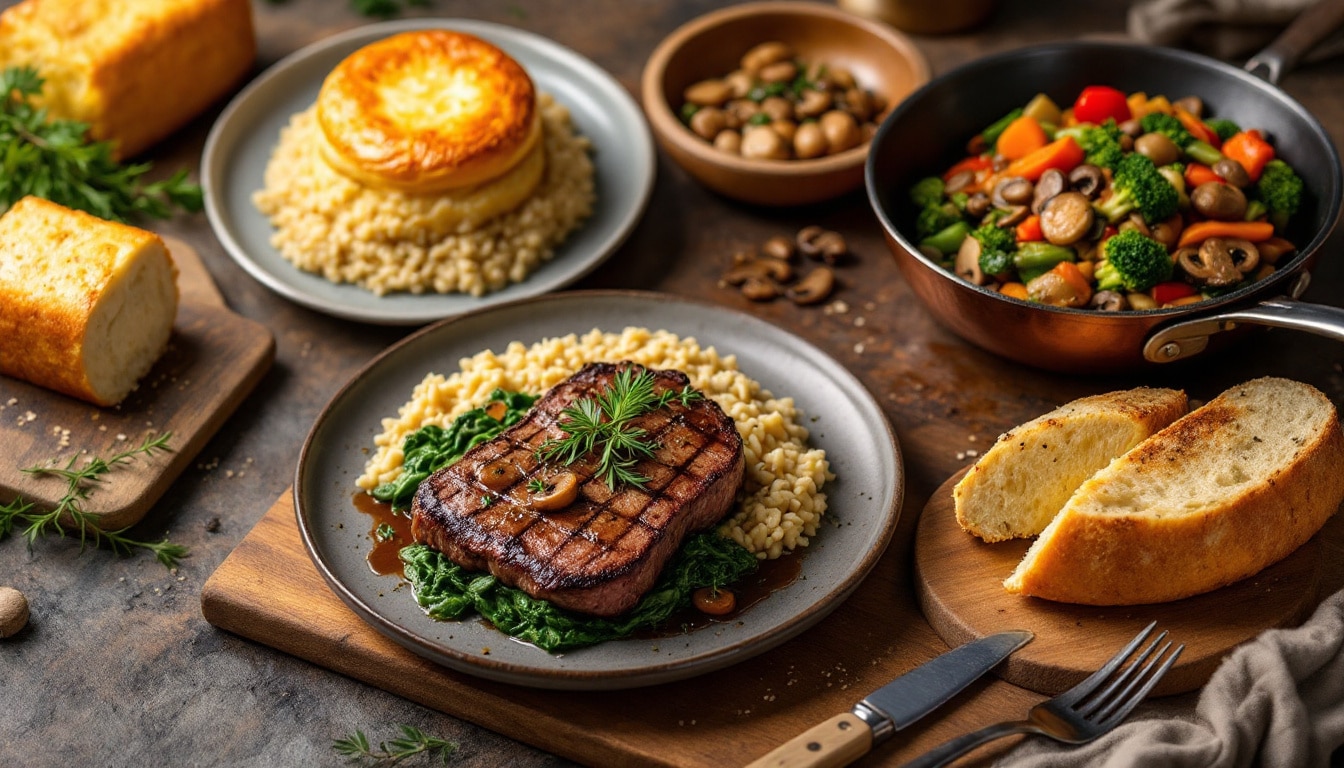Plongée dans la Gastronomie Française
Il est souvent dit que la cuisine française est l’une des plus raffinées et variées au monde. Chaque plat est le reflet d’un patrimoine culturel riche et d’une histoire gastronomique fascinante. Que ce soit pour un repas en famille ou un dîner entre amis, il existe des recettes incontournables qui méritent d’être maîtrisées. Dans cet article, nous allons découvrir 10 plats traditionnels français, des classiques réconfortants et emblématiques qui vont égayer vos repas et ravir vos convives.
Les Indispensables de la Cuisine Française
Avant de se plonger dans les recettes, il est important de noter que la cuisine française est un véritable festival de saveurs et de textures. Chaque plat a été perfectionné au fil des années et est souvent lié à une région ou à une tradition spécifique. Voici une liste des plats que nous allons explorer :
- Boeuf Bourguignon
- Blanquette de Veau
- Coq au Vin
- Soupe à l’Oignon
- Ratatouille
- Tarte Tatin
- Quiche Lorraine
- Pissaladière
- Tartiflette
- Crêpes Suzette
Le Boeuf Bourguignon : un Classique Indémodable
Le boeuf bourguignon est l’une des recettes les plus emblématiques de la cuisine française, originaire de la Bourgogne. C’est un ragoût de viande de boeuf cuit lentement dans du vin rouge, généralement du Bourgogne, accompagné de carottes, d’oignons et de champignons.
Ingrédients Necessaires
Pour préparer ce délice, voici les ingrédients nécessaires :
| Ingrédients | Quantité |
|---|---|
| Boeuf (Macreuse ou gîte) | 1 kg |
| Vin Rouge | 750 ml |
| Carottes | 4 |
| Oignons | 3 |
| Champignons de Paris | 250 g |
| Herbes de Provence | 1 cuillère à café |
| Ail | 3 gousses |
| Huile d’olive | 2 cuillères à soupe |
Instructions de Préparation
1. Découpez la viande en morceaux et faites-la revenir dans une cocotte avec de l’huile d’olive jusqu’à ce qu’elle soit bien dorée.
2. Ajoutez les oignons émincés, les carottes coupées et l’ail écrasé, puis laissez cuire quelques minutes.
3. Incorporez le vin rouge, les herbes de Provence et couvrez. Laissez mijoter à feu doux pendant environ 3 heures.
4. Pendant la dernière demi-heure de cuisson, ajoutez les champignons coupés en quartiers.
Servez votre boeuf bourguignon avec des pommes de terre vapeur ou une bonne purée maison pour un repas réconfortant.
La Blanquette de Veau : Douceur et Crémeux
Un autre plat réconfortant à maîtriser est la blanquette de veau. Ce ragoût crémeux est généralement servi avec du riz ou des pâtes. La préparation nécessite un bon bouillon de viande, des légumes, et une sauce béchamel enrichie en crème.
Ingrédients Necessaires
| Ingrédients | Quantité |
|---|---|
| Veau (épaule ou collier) | 1 kg |
| Carottes | 3 |
| Oignons | 2 |
| Crème Fraîche | 200 ml |
| Beurre | 60 g |
| Farine | 2 cuillères à soupe |
| Citron | 1 |
Instructions de Préparation
1. Dans une cocotte, faites dorer les morceaux de veau dans du beurre. Ajoutez les oignons et les carottes en rondelles.
2. Saupoudrez de farine et remuez bien.
3. Ajoutez de l’eau à hauteur et laissez mijoter 1 heure 30.
4. Ajoutez la crème et le jus de citron dans la cocotte et laissez encore mijoter 20 minutes.
La blanquette est prête à être servie, accompagnée de riz blanc pour un plat savoureux et doux au palais.
Le Coq au Vin : Un Plat Rustique et Réconfortant
Lorem ipsum dolor sit amet, consectetur adipiscing elit. Integer euismod, nisl eget dictum commodo, nisl nisl pretium quam, eu facilisis massa erat ut mauris. Ut pretium ligula ut tortor dignissim, et aliquam quam facilisis. Le coq au vin est un plat souvent préparé lors des repas dominicaux et qui rassemble autour de la table.
Ingrédients Necessaires
| Ingrédients | Quantité |
|---|---|
| Coq | 1 kg |
| Vin Rouge | 1 bouteille |
| Carottes | 3 |
| Oignons | 4 |
| Champignons | 250 g |
Instructions de Préparation
Commencer par faire mariner le coq avec le vin, les carottes et les oignons pendant 12 heures. Ensuite, faites revenir la viande et les légumes avant d’ajouter la marinade
La Soupe à l’Oignon : Réconfort Incontournable
La souper à l’oignon est une recette classique des brasseries parisiennes. C’est une soupe qui allie douceur et réconfort, parfaite pour les soirées d’hiver.
Ingrédients Necessaires
| Ingrédients | Quantité |
|---|---|
| Oignons | 500 g |
| Bouillon de Viande | 1 L |
| Pain | 4 tranches |
| Fromage (Gruyère) | 100 g |
Instructions de Préparation
Caramélisez les oignons dans une casserole, ajoutez le bouillon et laissez mijoter. Servez avec du pain grillé et du fromage fondu.
La Ratatouille : Légèreté et Saveurs Méditerranéennes
Un autre plat qui évoque l’été est la ratatouille, ce mélange coloré de légumes d’été qui rappelle les marchés provençaux.
Ingrédients Necessaires
| Ingrédients | Quantité |
|---|---|
| Aubergines | 2 |
| Courgettes | 2 |
| Poivrons | 2 |
| Tomates | 4 |
Instructions de Préparation
Coupez tous les légumes en dés, faites-les revenir dans de l’huile d’olive, assaisonnez et laissez mijoter jusqu’à ce qu’ils soient tendres. Servez chaud ou froid, selon votre préférence.
La Tarte Tatin : Douceur Inversée
La tarte Tatin est une des plus célèbres tartes aux pommes. Elle est cuite à l’envers, avec des pommes caramélisées.
Ingrédients Necessaires
| Ingrédients | Quantité |
|---|---|
| Pommes | 1 kg |
| Sucre | 150 g |
| Pâte Brisée | 1 rouleau |
Instructions de Préparation
Caramélisez les pommes dans le sucre, placez-les dans un moule, recouvrez de pâte et enfournez jusqu’à dorure.
La Quiche Lorraine : Simplicité et Saveurs
Iconique, la quiche Lorraine est une tarte salée riche en crème et lardons.
Ingrédients Necessaires
| Ingrédients | Quantité |
|---|---|
| Œufs | 3 |
| Crème Fraîche | 200 ml |
| Lardons | 200 g |
Instructions de Préparation
Faites revenir les lardons, mélangez les œufs et la crème, et versez sur la pâte. Cuire au four jusqu’à ce que la quiche soit dorée.
La Pissaladière : Tradition Niçoise
Une spécialité de la Côte d’Azur, la pissaladière est une tarte aux oignons et aux anchois.
Ingrédients Necessaires
| Ingrédients | Quantité |
|---|---|
| Pâte à Pain | 1 rouleau |
| Oignons | 500 g |
| Anchois | 100 g |
Instructions de Préparation
Étalez la pâte, ajoutez les oignons caramélisés et les anchois, puis enfournez.
La Tartiflette : Chaleur Montagnarde
Plat à base de pommes de terre et de fromage, la tartiflette est parfaite pour les soirées d’hiver.
Ingrédients Necessaires
| Ingrédients | Quantité |
|---|---|
| Pommes de Terre | 1 kg |
| Reblochon | 1 |
| Lardons | 250 g |
Instructions de Préparation
Faites cuire les pommes de terre, ajoutez les lardons, puis recouvrez de reblochon et enfournez jusqu’à ce que le fromage soit fondu.
Les Crêpes Suzette : La Douceur Flamboyante
Pour terminer, les crêpes Suzette sont un dessert emblématique de la France, flambé à l’orange.
Ingrédients Necessaires
| Ingrédients | Quantité |
|---|---|
| Farine | 250 g |
| Œufs | 4 |
| Beurre | 50 g |
Instructions de Préparation
Préparez une pâte à crêpes, faites cuire et servez flambées avec une sauce d’orange.
En Route pour la Cuisine !
Ces plats sont des incontournables de la gastronomie française. Les maîtriser, c’est une invitation à partager des moments de convivialité autour de la table. Que vous soyez novice ou cuisinier expérimenté, ces recettes vous permettront de transmettre un peu de l’art culinaire à vos proches. Alors, mettez votre tablier, préparez vos ingrédients et lancez-vous dans la préparation de ces délices ! Pour encore plus d’inspirations, découvrez d’autres recettes incontournables pour maîtriser l’art gastronomique à la maison : 10 recettes incontournables.






